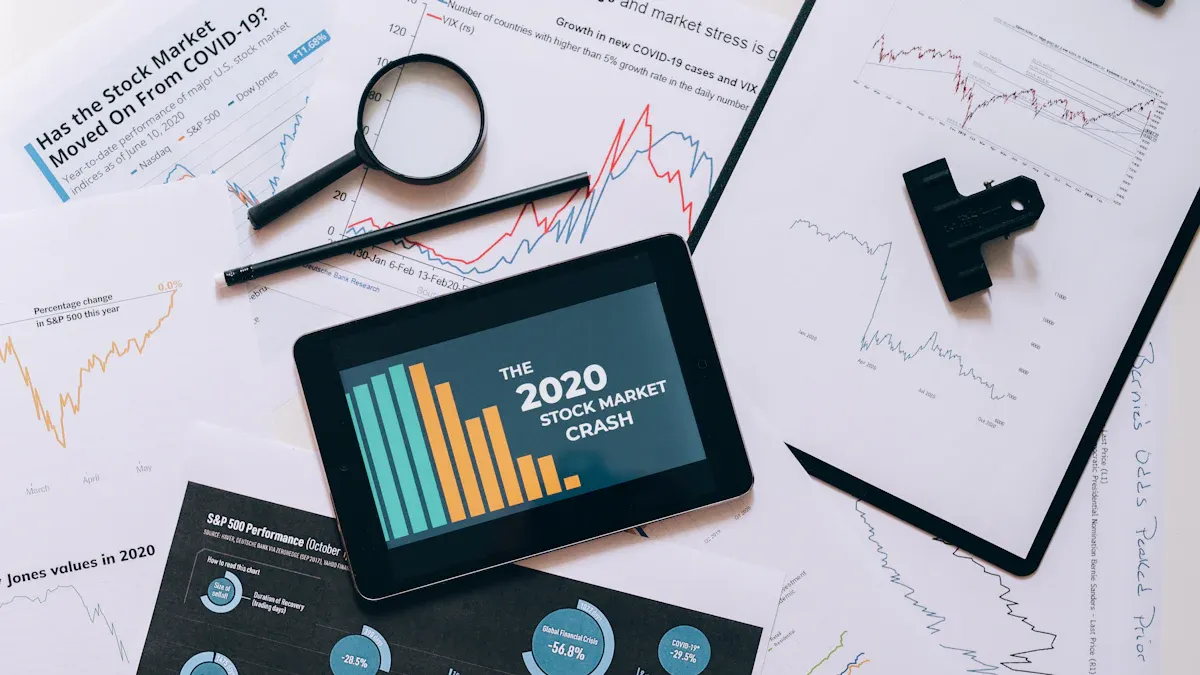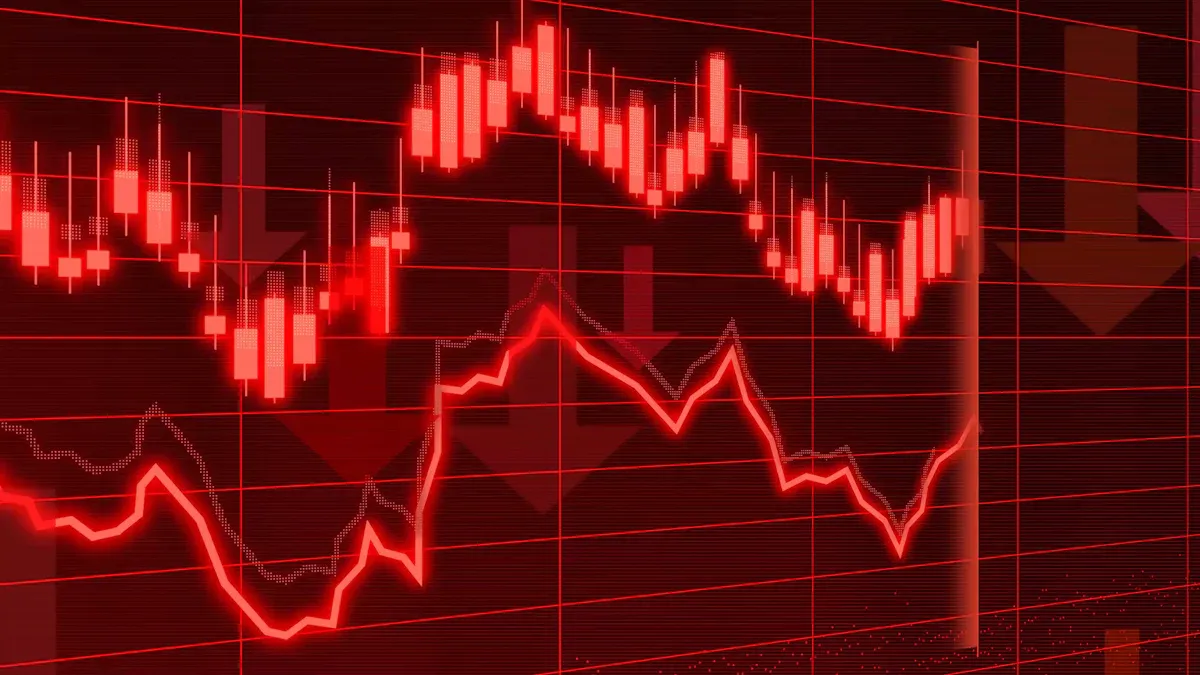- EasyCard
- Trade
- Help
- Announcement
- Academy
- SWIFT Code
- Iban Number
- Referral
- Customer Service
- Blog
- Creator
Do the Reasons for U.S. Stock Market Crashes Always Drag Down the Economy?

Image Source: unsplash
The reasons for U.S. stock market crashes are complex and varied, and their impact depends on specific circumstances. Some statistics reveal the economic consequences of crashes. For example, about 30% of American households may face bankruptcy risk due to financial crises, reflecting increased financial pressure on households. The consumer confidence index also dropped significantly in a short period, falling from 71.7 in January to 64.7 in February, hitting a 15-month low. These data indicate that U.S. stock market crashes are not only related to market sentiment but may also signal potential risks of economic recession.
Key Takeaways
- U.S. stock market crashes may lead to increased financial pressure on households, with about 30% of households facing bankruptcy risk.
- A decline in the consumer confidence index directly affects consumer spending, as households tend to reduce expenditures during economic uncertainty.
- Reduced corporate investment impacts production capacity, leading to fewer job opportunities and further dragging down economic growth.
- The government’s ability to respond promptly is crucial for economic recovery, with transparency and execution enhancing public trust.
- Changes in the international economic environment affect the domestic economy through trade and investment, making policy coordination particularly important.
Reasons for U.S. Stock Market Crashes

Image Source: pexels
Deterioration of Economic Fundamentals
The deterioration of economic fundamentals is one of the important reasons for U.S. stock market crashes. When economic growth slows or shows signs of recession, investor confidence in corporate profitability declines, putting pressure on the stock market. For example, before the 1987 stock market crash, the debt ratio of U.S. non-financial companies rose to over 40% of GDP, and currently, this ratio has reached 47%. High debt levels trigger financial risks for companies, making the market more concerned about economic prospects. Additionally, after the 1987 crash, the U.S. economy still maintained about 5%, while current economic growth is only stable at around 2%. This comparison shows that changes in economic fundamentals directly affect market performance.
The deterioration of economic fundamentals may also transmit to the stock market through the labor market and consumer spending. A weak labor market reduces household income, thereby suppressing consumer demand. Declining corporate profitability reduces investment activities, further dragging down economic growth. This vicious cycle creates a close connection between the reasons for U.S. stock market crashes and economic fundamentals.
Market Sentiment and Panic Selling
Market Dynamics
Fluctuations in market sentiment and panic selling are another major trigger for U.S. stock market crashes. When investors feel uncertain about the market outlook, emotional decision-making can trigger dramatic market volatility. Market trading volume, investor sentiment indices, as well as public opinion from social media, and news reports are key indicators for measuring market sentiment. Data shows that deteriorating market sentiment often triggers a chain reaction, leading investors to sell stocks in a concentrated manner, thereby exacerbating market declines.
Panic selling is typically accompanied by irrational market behavior. Investors selling large quantities of assets in a short period may trigger stock prices to drop far below their actual value. This phenomenon not only affects market stability but may also trigger negative impacts on economic activities. Declining consumer confidence and reduced corporate investment are often direct consequences of panic selling.
Policy Changes and External Shocks
The impact of policy changes and external shocks on U.S. stock market crashes cannot be overlooked. The U.S. tariff hike policy once led to a decline in oil demand for crude oil, exacerbating market concerns about an economic recession. Additionally, OPEC+’s decision to increase output led to significant changes in market expectations for oil prices, further impacting investor confidence. Analysts predict that these policy changes may trigger a negative impact on U.S. economic growth and even trigger a recession.
The impact of external shocks is equally significant. China’s foreign exchange market has shown strong stability and resilience in a complex external environment, providing an important reference for global markets. Foreign exchange authorities have expanded corporate financing opportunities by raising macroprudential adjustment parameters for cross-border financing. At the same time, they issued the Guidelines for Exchange Rate Risk Management for Enterprises, helping companies establish exchange rate risk management mechanisms. These measures have, to some extent, mitigated the impact of external shocks on the market, providing a reference for other countries.
The combination of policy changes and external shocks often exacerbates market uncertainty. Investors, when facing a complex policy environment, may adopt more cautious investment strategies, thereby profoundly impacting the stock market.
Short-Term Economic Impacts of U.S. Stock Market Crashes
Decline in Consumer Confidence
The decline in consumer confidence is one of the important manifestations of the short-term economic impact of U.S. stock market crashes. Data shows that in April 2025, the U.S. consumer confidence index fell to 86, below the market expectation of 87.5 and March’s 93.9. This change reflects consumers’ concerns about economic prospects. Consumers’ expectations for future income turned markedly negative for the first time, with the proportion expecting fewer job opportunities in the next six months rising to 32.1%, approaching levels seen during the 2009 global financial crisis.
The decline in consumer confidence directly affects consumer spending. Households tend to reduce non-essential expenditures when facing economic uncertainty, thereby suppressing economic activity. Persistent low consumer confidence may further exacerbate economic weakness, forming a vicious cycle.
Reduced Corporate Investment
Reduced corporate investment is another short-term impact of U.S. stock market crashes. Data shows that in the fourth quarter of 2022, data center transaction volume was only $453.6 million, hitting the lowest level since the third quarter of 2020. This trend indicates that companies tend to reduce capital expenditures when economic uncertainty intensifies.
Reduced corporate investment not only affects production capacity but may also lead to fewer job opportunities. The decline in investment activities is usually accompanied by companies’ pessimistic expectations for future profitability, further dragging down economic growth.
| Time | Data Center Transaction Volume (USD Billion) | Remarks |
|---|---|---|
| 2021 | 8.2 | Total sales for 2021 |
| Q1 2022 | Over 9.0 | Majority of sales concentrated in Q1 |
| Q4 2022 | 0.4536 | Lowest since Q3 2020 |
Increased Financial Market Volatility
Increased financial market volatility is one of the direct consequences of U.S. stock market crashes. Market volatility indicators show that historical volatility, implied volatility, and realized volatility have all risen significantly. Implied volatility reflects investors’ expectations for future market fluctuations, while realized volatility estimates true volatility through non-parametric methods. The changes in these indicators indicate that market uncertainty is intensifying.
Rising volatility is typically accompanied by dramatic asset price fluctuations. Investors may adopt more conservative strategies when facing high volatility, thereby reducing market liquidity. This phenomenon not only affects the stability of financial markets but may also trigger negative impacts on the real economy.
- Historical Volatility: Calculated based on historical price changes, often used to predict future price fluctuations.
- Implied Volatility: Reflects investors’ expectations for future market fluctuations, derived from the options market.
- Realized Volatility: Estimates true volatility through non-parametric methods, transformed into an observable explicit variable.
Long-Term Economic Impacts of U.S. Stock Market Crashes

Image Source: pexels
Labor Market Weakness
Labor market weakness is an important manifestation of the long-term economic impact of U.S. stock market crashes. Initial jobless claims rose to 240,000, exceeding market expectations. Continuing claims reached 1.919 million, far surpassing the previous value of 1.893 million. These data indicate that economic uncertainty is exerting pressure on the labor market. Companies, when facing declining profitability, typically reduce hiring activities or even lay off employees to cut costs.
Rising unemployment not only affects household income but may also lead to further contraction in consumer demand. Consumers’ pessimistic expectations for future income exacerbate this trend. Labor market weakness forms a vicious cycle in economic activity, hindering the pace of long-term economic recovery.
Declining Corporate Profitability
Declining corporate profitability is another long-term impact of U.S. stock market crashes. The gross profit margin in the social services industry fell from 31.54% to 23.9%, with its ranking dropping from 4th to 11th across all industries. Profitability in sports and professional services also saw significant declines. The gross profit margins in the hospitality, catering, and tourism industries were similarly impacted, reflecting a broad slowdown in economic activity.
Declining profitability forces companies to reduce capital expenditures and R&D investments. This trend not only affects companies’ competitiveness but may also lead to a decline in industry innovation capacity. Companies, when facing profitability pressures, typically adopt conservative strategies, further dragging down economic growth.
Global Economic Linkage Effects
The impact of U.S. stock market crashes is not limited to the U.S. domestic market but spreads to other countries through global economic linkage effects. The GVAR model shows significant global economic spillover effects. Core variables include consumer price indices, construction industry output, exchange rates, and global oil and non-oil prices. These indicators reflect different countries’ responses to economic shocks.
Directly linked countries like Australia and Peru are more noticeably affected, while indirectly linked countries like India and South Africa exhibit varying degrees of economic fluctuations. This linkage effect indicates that U.S. stock market crashes may transmit to the global economy through trade, investment, and financial markets. The complexity of the international economic environment further exacerbates this impact, making the coordination of economic policies across countries particularly important.
Key Factors Determining Whether the Economy Is Dragged Down
Government Policy Response Capability
The government’s policy response capability plays a crucial role in determining whether the economy is dragged down. Effective policies can mitigate market panic and stabilize economic operations. The government collects and analyzes data through various channels to support decision-making. For example, census data and camera data provide a foundation for economic trend analysis. Data from public comments and mayor’s mailboxes is vast, and after classification and analysis, it becomes an important governance resource.
In the era of big data, the support of cross-disciplinary technical officials is particularly important. They can enhance data processing capabilities, helping the government quickly identify economic issues and implement targeted measures. For instance, when the market experiences dramatic fluctuations, the government can stabilize market sentiment by adjusting monetary or fiscal policies. The timeliness and precision of policies directly affect the speed of economic recovery.
Additionally, the transparency and execution of policies determine their effectiveness. The higher the public’s trust in policies, the more significant their implementation effects. The government needs to enhance public confidence by disclosing data and strengthening communication, thereby reducing market uncertainty.
Economic Resilience and Structural Adjustment
Economic resilience is an important indicator of an economy’s ability to withstand shocks. An economy with high resilience can recover quickly from external shocks and maintain long-term growth. The diversity and flexibility of economic structures are key factors in enhancing resilience. For example, an economy reliant on a single industry is more vulnerable to global market fluctuations, while a diversified economic structure can spread risks.
Structural adjustment is an effective means to enhance economic resilience. By optimizing industrial structures, the government can reduce dependence on traditional industries and promote the development of emerging industries. For instance, the manufacturing purchasing managers’ index has risen for two consecutive months, indicating continued improvement in market expectations. This positive signal reflects the effectiveness of economic structural adjustments.
Additionally, growth in fixed asset investment provides support for the economy. Data shows that fixed asset investment grew by 4.2% year-over-year, and industrial value-added increased by 6.3%. These data indicate that the economy, after experiencing short-term fluctuations, still possesses strong recovery capabilities. Structural adjustments not only enhance the economy’s risk resistance but also lay a foundation for long-term development.
Impact of the International Economic Environment
The impact of the international economic environment on the domestic economy cannot be ignored. In the context of globalization, economies are closely interconnected through trade, investment, and financial markets. One of the reasons for U.S. stock market crashes is external shocks, which often transmit to other countries through international economic linkage effects. For example, global economic growth reached 5.4% in the first quarter, higher than the 1.2% in the fourth quarter of the previous year. This growth reflects positive recovery trends in some countries but may also intensify market competition.
The performance of the service and manufacturing sectors is similarly affected by the international environment. Data shows that service sector value-added grew by 5.3% year-over-year, and the rise in the manufacturing purchasing managers’ index further indicates improving market expectations. However, uncertainties in the international market may still exert pressure on these industries.
The complexity of the international economic environment requires countries to strengthen policy coordination. Through multilateral cooperation, countries can jointly address global economic fluctuations, reducing the impact of external shocks on domestic economies. Changes in the international economic environment not only affect market confidence but also pose higher demands on policy formulation.
The impact of U.S. stock market crashes on the economy is multidimensional, with specific outcomes depending on multiple factors. Market fluctuations not only reflect changes in economic fundamentals but are also influenced by policy adjustments and external shocks.
The Federal Reserve’s interest rate cuts have gradually become an important tool for addressing uncertainty shocks, rather than merely cyclical stimulus measures. Changes in the inflation path also indicate that the market’s response to policies is shifting from hypersensitivity to greater rationality. In the future, the pace of rate cuts will depend more on macroeconomic data rather than being triggered by single events.
Analyzing market fluctuations from multiple dimensions helps avoid one-sided interpretations. Investors and policymakers need to focus on economic resilience, policy response capabilities, and changes in the international environment to gain a more comprehensive understanding of market dynamics.
FAQ
What are the main reasons for U.S. stock market crashes?
The main reasons for U.S. stock market crashes include deteriorating economic fundamentals, market sentiment fluctuations, and policy changes. Slowing economic growth or declining corporate profitability triggers investor concerns. Market panic selling and external shocks (such as international trade frictions) may also lead to significant market declines.
Do U.S. stock market crashes always lead to economic recessions?
U.S. stock market crashes do not always lead to economic recessions. Whether the economy is dragged down depends on economic resilience, government policy response capabilities, and the international economic environment. If policies are timely and effective, the economy may recover quickly, avoiding long-term recession.
How should investors respond to U.S. stock market crashes?
Investors should avoid panic selling and remain rational. Diversifying investment risks, focusing on long-term investment goals, and regularly adjusting asset allocations are effective strategies. Understanding market fundamentals and policy changes helps make more informed decisions.
Tip: Investors can refer to professional analysis reports to avoid blindly following trends.
What is the impact of U.S. stock market crashes on ordinary households?
U.S. stock market crashes may lead to a reduction in household wealth, especially for families reliant on stock investments. Declining consumer confidence may prompt households to reduce consumer spending, affecting quality of life. Reasonable financial planning and savings can reduce risks.
How can the government mitigate the negative impacts of U.S. stock market crashes?
The government can stabilize markets through monetary policies (such as interest rate cuts) and fiscal policies (such as increasing public investment). Strengthening cooperation with international economies also helps reduce external shocks. Policy transparency and execution are critical to restoring market confidence.
Data Support: Historical data shows that timely policy interventions can significantly shorten economic recovery times.
U.S. stock market crashes amplify uncertainty, requiring investors to swiftly reposition funds to mitigate risks or seize rebound opportunities. BiyaPay offers a seamless platform to access U.S., Hong Kong, or global markets without needing overseas accounts, enabling investments in defensive sectors or high-potential assets. Convert over 30 fiat currencies with 200+ cryptocurrencies and track real-time fiat exchange rates to navigate currency fluctuations, with transfer fees as low as 0.5% across 190+ countries for rapid market response. Try BiyaPay now for secure, efficient transactions. Licensed by U.S. MSB and SEC, BiyaPay ensures trust and compliance. During volatile times, grow idle funds with a 5.48% APY flexible savings product, accessible anytime, aligning with dynamic market needs. Sign up with BiyaPay to strengthen your investment strategy today!
*This article is provided for general information purposes and does not constitute legal, tax or other professional advice from BiyaPay or its subsidiaries and its affiliates, and it is not intended as a substitute for obtaining advice from a financial advisor or any other professional.
We make no representations, warranties or warranties, express or implied, as to the accuracy, completeness or timeliness of the contents of this publication.




Contact Us
Company and Team
BiyaPay Products
Customer Services
BIYA GLOBAL LLC is a licensed entity registered with the U.S. Securities and Exchange Commission (SEC No.: 802-127417); a certified member of the Financial Industry Regulatory Authority (FINRA) (Central Registration Depository CRD No.: 325027); regulated by the Financial Industry Regulatory Authority (FINRA) and the U.S. Securities and Exchange Commission (SEC).
BIYA GLOBAL LLC is registered with the Financial Crimes Enforcement Network (FinCEN), an agency under the U.S. Department of the Treasury, as a Money Services Business (MSB), with registration number 31000218637349, and regulated by the Financial Crimes Enforcement Network (FinCEN).
BIYA GLOBAL LIMITED is a registered Financial Service Provider (FSP) in New Zealand, with registration number FSP1007221, and is also a registered member of the Financial Services Complaints Limited (FSCL), an independent dispute resolution scheme in New Zealand.




















